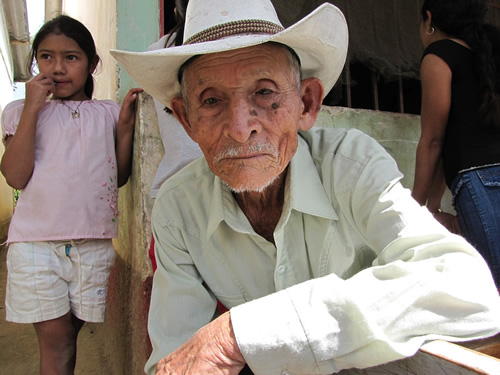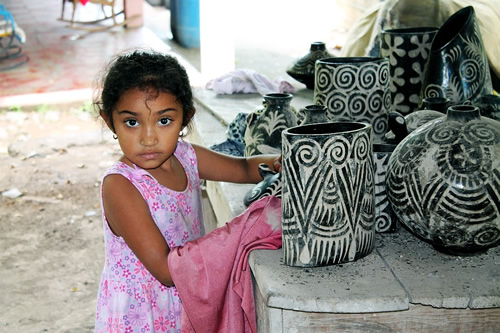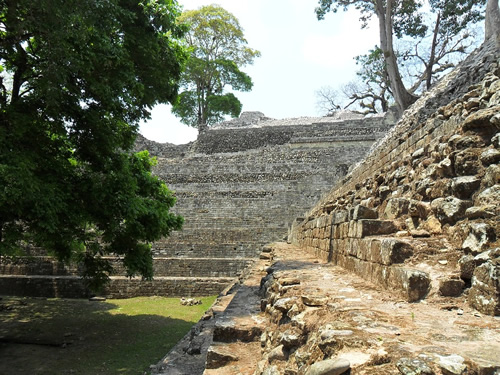Learn Spanish in Honduras
Explore a Little-Known Country While Improving Your Language Skills
By Volker Poelzl

|
|
Older man and young girl in Honduras.
|
With growing economic ties and the movement of goods and human resources between North America and Latin America, Spanish is an increasingly important language for trade, business, and education. During this time of a weak dollar, Central America has become especially attractive for studying Spanish. It is not only cheaper than Mexico or Spain, but the region’s six Spanish-speaking countries also have great cultural diversity and natural beauty. Guatemala and Costa Rica are no doubt the region’s most popular destinations. Regardless, Honduras is beginning to emerge as a place where there is a good selection of Spanish schools located in some attractive areas.
Honduras is known to some North Americans in what is now the very politically loaded term “Banana Republic” due to the country’s prolonged economic dependency on banana exports. It is a little-known fact that Honduras offers incredible natural beauty and a diverse landscape, from tropical rainforests and pristine beaches to mountains covered in cloud forests, as well as spectacular Mayan ruins and quaint colonial towns. Students will find the local people to be friendly, helpful, and always interested in conversation. In addition, the cost of living in Honduras is one of the lowest in Central America.

|
|
A young Honduran girl with traditional pottery.
|
Finding a Spanish School in Honduras
The easiest way to find a Spanish school in Honduras is to book a course with an international referral organization. Agencies are somewhat more expensive than booking directly with a school in Honduras. Still, your referral fee often comes with a satisfaction guarantee and the flexibility to transfer to a different school referred by the same organization. However, if you don’t mind researching, you can find a language school independently.
The course fees don’t vary much, but you should read the fine print and find out what is included. Contact several schools and compare their prices, services, and courses. How many hours of instruction are part do you have in class? What are the class sizes? Most Spanish schools in Honduras offer one-on-one instruction, but group instruction is also usually provided. Course fees in Honduras are around $200-300 per week for twenty hours of instruction. Don’t forget to inquire about the cancellation and refund policies if you are unsatisfied with your course. Also, keep in mind that some schools offer college credit, while others teach language proficiency without awarding a certificate.
While it is important to attend class and study vocabulary, syntax, and grammar, it is equally essential to practice conversation and practice total immersion. Living with a host family is generally the best way to use your Spanish in daily situations. Inquire if your school refers homestays so you get to live with a local family while you attend classes. Find out if the homestay fee includes three meals each day. Staying with a family in Honduras with meals included costs around $100 per week or may be included in the course fee. Staying at a hotel or renting an apartment will be more expensive.
A growing number of language schools in Honduras offer volunteer opportunities for their students. Just like other Central American countries, Honduras suffers from poverty and social inequalities, so volunteering is a great way to improve your Spanish, become immersed in the local culture, and contribute to improving the living conditions of the local population. If interested in volunteer work, find out if your school works with any aid projects, as many do, or if any local organizations might need your help.
Choosing Where to Study
Another important consideration is the location of the school. Do you like the Caribbean Sea or the highlands and mountains? Do you prefer the quiet atmosphere of a small town or a mid-size city with a vibrant nightlife? Choose a location offering plenty of leisure activities, so you have exciting things to do after class and on weekends. Honduras is still a frontier land regarding tourism infrastructure. Still, services are gradually improving, and language students will find many attractive destinations and things to do in their spare time.
Ideally, there should be more than one school in the location of your choice so you can compare courses, prices, and services and choose a school that best meets your needs. Some schools have branches in several towns or are affiliated with international referral organizations, which allow you to study at more than one location, which is a great way to get to know different parts of the country.
Although there are fewer language school destinations in Honduras than in Guatemala or Costa Rica, students have the advantage of studying in picturesque and lively towns with few foreigners, where they can more easily meet the local people and practice their language skills. If you have ever studied abroad, you know how tempting it is to spend time with other English speakers instead of struggling to communicate with the locals in Spanish. Except for the Bay Islands, there are no places in Honduras with large numbers of English-speaking travelers or expatriates, which increases your chance to practice your Spanish daily.
There are two primary locations to consider: La Ceiba is a bustling city on the Caribbean coast, and Copán is a small, picturesque town in the Western Highlands near the Guatemalan border.
La Ceiba
La Ceiba is the third-largest city in Honduras — with approximately 150,000 inhabitants — and it is the main commercial center on the Caribbean coast. Most foreign visitors just pass through La Ceiba on their way to the well-known diver’s paradise of the Honduran Bay Islands, but the city has a pleasant Caribbean ambience and a number of nearby natural attractions. There are several pristine beaches, and the Pico Bonito National Park and Cuero y Salado Wildlife Refuge give outdoors enthusiasts the opportunity to hike in the rain forest and explore rivers, lagoons, and waterfalls. And for those interested in snorkeling, diving or a weekend get-away, the Bay Islands are only about an hour away by ferry.
If you enjoy urban culture, entertainment, and nightlife, studying Spanish in La Ceiba is your best choice. There are many bars, restaurants, and clubs located in the “Zona Viva,” the entertainment district near the center. Most dance clubs, restaurants, and bars are clustered in these districts, making it easy to enjoy a night out on the town, all within a few city blocks.
The local people are a colorful mix of mestizos (of mixed Indian and European descent), Creoles (descendants of enslaved Africans), and Garífuna (of mixed African and Carib Indian descent), who give the city its vibrant character — several small Garífuna communities near La Ceiba, where visitors can enjoy traditional culture and great beaches.
While La Ceiba receives few visitors during the year, this changes in May, when the town celebrates the day of its patron saint, San Isidro, with a sizeable week-long celebration complete with floats, parades, costumes, music, and food. Easter week is another time of year when the city fills up with tourists visiting to spend their vacation on the Caribbean coast.
Copán Ruinas

|
|
Copas Ruinas.
|
The small town of Copán, located in a fertile valley in the Western Honduran Highlands, is mainly known for its spectacular Mayan ruins. Although the Copán ruins are among the most popular tourist attractions in Honduras, the town still maintains its laidback and pleasant atmosphere. Compared to La Ceiba, the nightlife in Copán is modest, and there are few venues to socialize, dance, and party, but the town itself has a quaint historic center with colonial buildings and a pleasant central square. The locals go about their lives largely unaffected by the tourists that pass through their town. In addition to the spectacular Mayan ruins, the region offers a lot of other recreational activities. There are several national parks in the area, with great hiking and several nearby colonial towns and historic sites.
For More Info
Copán Spanish School is a Spanish language immersion school with a staff of teachers with decades of teaching experience to help you learn in a one-on-one learning environment. Learn Spanish at your preferred pace.
To learn more about Honduras, check out the following websites:
Lonely Planet Honduras
Honduras Travel
|
Volker Poelzl is a Living Abroad Contributing Editor for TransitionsAbroad.com. A travel writer fluent in five languages he regularly writes about Language Learning and cultural immersion.
|
